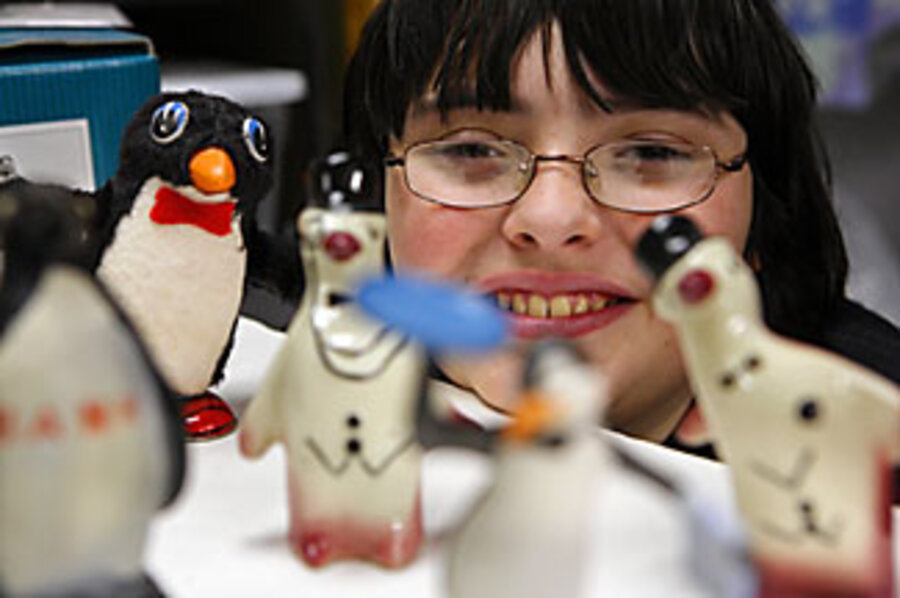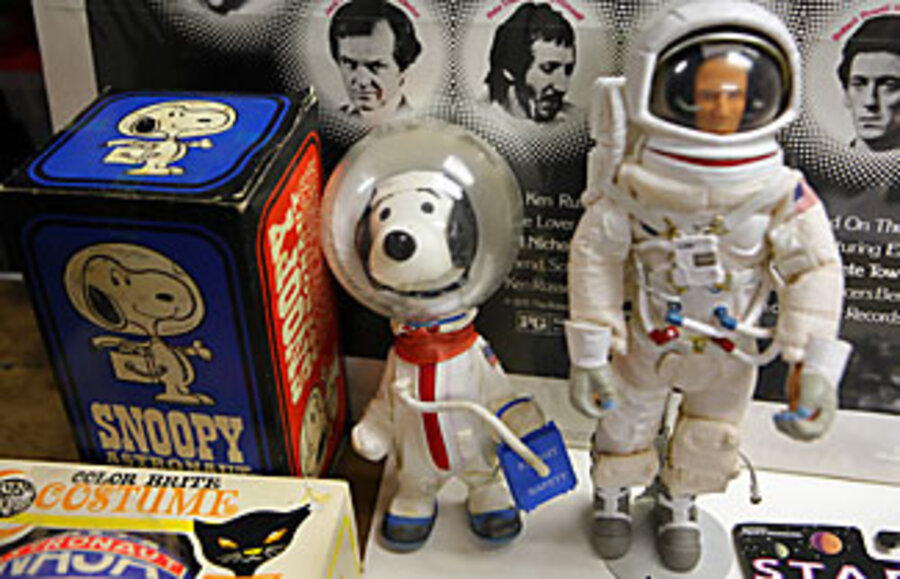Where have all the pint-sized collectors gone?
Loading...
Angela Watson remembers the pleasure of childhood stamp collecting. Whenever friends and family gave her stamps, especially from foreign countries, she would study them. Then she would turn to the Encyclopedia Britannica for more information.
"Stamps provided a large part of my education in history, geography, science, and nature," says Ms. Watson of Long Beach, Calif.
Today far fewer youngsters are involved in the traditional "big three" of children's collecting – stamps, coins, and sports cards.
As Watson explains, "Getting kids interested in 'traditional' hobbies can be very difficult because we are competing with video games, skateboards, and TV."
That leaves adult collectors scrambling to find ways to draw a new generation of enthusiasts. Stamp clubs, Watson notes, are trying to attract children with free stamps and appealing activities.
"Kids used to collect stamps because it was a glimpse into a world you couldn't see just by turning on a computer [as they can today]," says Will Seippel, a father of five and CEO of WorthPoint, a database for collectibles. "If you were growing up in Baltimore, a stamp was a way to see Cameroon. Today there's not the primary lure of the distant land."
People collect for three reasons – nostalgia, decorative purposes, and investment, says Gary Sohmers of Framingham, Mass., who appraises collectibles for the Antiques Roadshow on PBS. He finds that collecting teaches children about maintaining objects and sharing their collections with friends and family. It also offers lessons in fair trading.
Mr. Sohmers's 12-year-old son, Thomas, is an avid collector of NASA memorabilia, computers, video games, and penguins, both figurines and stuffed animals.
For a time, baseball cards became more popular than coin collecting for children, says Mark Albarian, president of Goldline International, a rare coin and precious metals trading firm. "Now that's changing because of the United States Mint. The state quarter program, new gold and silver coins, and the new Lincoln pennies for 2009 have brought coin collecting to center stage."
Many children attend coin shows, and the American Numismatic Association hosts merit badge clinics for Boy Scouts at its two annual conventions.
In sports collectibles, Major League Baseball and the sports card companies have conducted advertising and marketing campaigns in recent years to continue to attract young people to the hobby.
The Internet is also changing the world of collecting. As founder of CoinTalk.com, an online community of coin collectors, Peter Davis provides a way for older collectors to mentor the younger generation.
"One of the things younger collectors have to face today that older folks didn't is the massive influx of Chinese counterfeit coins into the hobby," he says. Online "marketplaces such as eBay have made it very profitable for Chinese counterfeiters to sell directly to the collecting public in the US, or to middlemen who pass counterfeits off as the real thing."
The Internet, particularly Wikipedia, "ruined" Brandon Mendelson's interest in trading cards. "When I was younger, I liked the trivia found on the back of each Marvel Comics card," says the Syracuse, N.Y., resident. "With the Internet, all the trivia can be found online, so it became a bit pointless to me to keep collecting them."
David Steinberger of New York, who collected comics when he was a boy, finds that comic book collectors today are generally viewed as an aging population. "Younger comic book readers generally don't view it as a collecting passion, but as a reading passion," he says. "Younger readers are more likely to buy collected editions or even download illegal copies online."
Mike Heffner, president of Lelands.com, a sports and pop culture memorabilia auction house, began collecting baseball cards when he was 7. "The hobby has changed so much over the past 30 to 40 years," he says. "Technology has taken over the simplicity of collecting. Cardboard just isn't as interesting anymore."
Collecting is also more expensive today and more businesslike, he adds. "Cards are not five or 10 cents anymore. Everything is governed by a price guide."
In addition, today's instant-gratification culture does not allow for the gradual appreciation of collected items. When Mr. Heffner was 10, he bought a box of baseball cards and stored it, unopened, under his bed until he turned 18. "I knew the cards would be worth more if the box remained unopened," he says. "I paid about $6 for that box of cards and sold it eight years later for $500. I don't know if kids today have that same discipline."
Whatever the objects of a young collector's passion, they can stir fond memories for decades.
As a girl, Jacqui Pini of Boston collected small dog figurines. She and her mother would go to yard sales on Saturdays and buy them. At one point she owned about 40 of the dogs.
"I would line them up on my shelves and play with them," she says. "I still have two porcelain poodles prominently placed in my house, and every time I look at them, it reminds me of collecting them with my mother."
Seippel urges parents to encourage children to pursue things they like: "Help them develop interests that aren't just on a video game. It may help if they see parents collect."
Lynette Bondarchuk of Edmonton, Alberta, Canada, started a "designer eraser" collection when she was 9, beginning with a tiny blue VW Bug eraser and a pair of pink lips. That youthful enthusiasm has now grown into an opportunity to collect with her young son.
"My son is 5 and gets excited when he sees funky erasers we can add to the collection, which now numbers about 800," she says.
They also collect fancy rocks and precious stones, such as geodes and amethysts. Collecting, she finds, "demonstrates a sense of commitment, and an opportunity for finding interest and taking pleasure in 'small things.' "
Susan Chait, creative director of a design firm in New York, and her husband collect pop culture. Their 9-year-old collects cards and Pez containers.
"Collecting is part of the fabric of our family," she says. "We take trips that become like treasure hunts to toy and comic book shows. Collecting objects has definitely made our life richer, giving us common ground and something to share."
Sohmers regards age 13 as an important milestone in collecting: "That's when boys discover girls and girls discover boys." Their interest in collecting wanes.
But when parents and their kids collect together, he says, "It's a way to bond and teach, whether it's picking up stones or stuffing leaves in a book. Preserving the past is better than trying to recapture it."






